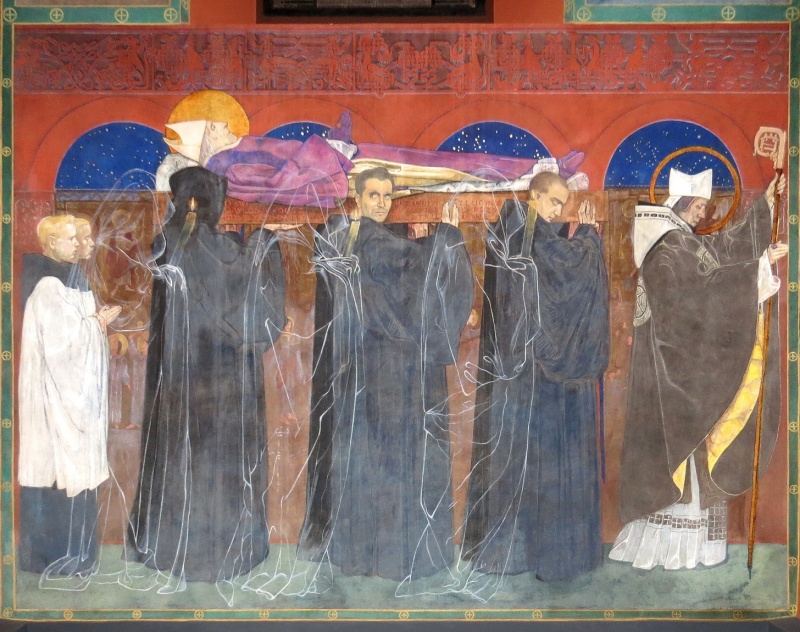
Maria Jaworska
Funeral of St. Odilo - fresco from the Armenian Cathedral of Lviv
The first two days of November are one of the most important holidays of the year. During the All Saints' and All Souls' Solemnities, we gather at cemeteries as a testament of remembrance - to light a candle and lay flowers or a wreath - on the graves of deceased family members, relatives, heroes or the famous. On the one hand, it is a time for contemplation and reflection on the inevitability of death and an opportunity to remember our deceased, whilst on the other hand, it is an opportunity to meet distant family and friends at a cemetery. During a break from the search for the most beautiful candle or the most magnificent chrysanthemum, it is worth considering not only the origin of both holydays, but also the role that they play in the social awareness in Poland and Hungary.
From paganism to Christianity
Veneration of the dead is present in almost every culture and is usually connected with the basic belief in the afterlife. Remembrance and worship of the deceased beyond the religious aspect is an integral part of the rituals practised within the family. As Adam Fischer said, a relationship develops where the dead look after the living and the living remember the dead. Thus, veneration of the dead was rooted among the peoples of pre-Christian Europe, and the traditions associated with it survived in some regions until the twentieth century. For a long time Christianity has been reluctant to accept these practices, mainly because of their festive character. Over time, however, as in the case of many other pagan traditions, they were given a new character and adapted to the calendar of ecclesiastical holydays.
Contemporary dates and celebrations of All Saints' Day derive from the tradition of the Western Church, when in the 10th century, the concept and the rite for the celebrations commemorating not only dead martyrs but also other saints (in the Eastern Church, the holyday was celebrated on May 13) were established. This date, originally announced in England, was intended to help convert pagans to Christianity who worshipped the Celtic feast of "All Hallow E'en" in those areas.
All Saints' Day in memory of all the dead (not only martyrs and saints) became commonplace almost 100 years later (in 998), when the abbot of the Benedictine Order in Cluny, France - later St. Odilo - decided that a mass for the deceased will be celebrated in all monasteries (numerous and powerful at that time) on November 2. As a result of this regulation, soon the celebration entered the liturgy of the entire Latin-speaking Church.
Halloween or Dziady?
When talking about the celebration of All Saints' and All Souls', one should bear in mind not only the rites of the church, but also traditions and celebrations in the villages It was mainly the 19th century studies of rural folklore that broadened our knowledge of various superstitions, precepts and culinary traditions characteristic of November 1st and 2nd. During this period, both for Halloween, which has its roots in Celtic beliefs, and for Dziady, described by Adam Mickiewicz, special rituals were performed, including the preparation of special fast dishes, lighting flames in houses, alms for "church dziady" (beggars), settling accounts with hired workers or dressing up. In both cases it was believed that feasting together with the deceased or leaving a meal for them would help on their way to eternal salvation.
(Post 1906 Postcard, "Dziady" by Mickiewicz)
The feature that distinguishes modern Halloween from festivals commemorating the dead, which are celebrated in Poland or Hungary, is the approach to the deceased. On Halloween, the dead, scary intruders who infiltrate our world, are unwanted. In the Catholic tradition within Central Europe, All Saints' Day is rather treated as a serene coming together with ancestors, a time of contemplation and pleasant memories. When we meet distant family members and friends at the graves or see a candle lit by someone who visited the grave before us, we feel that even after death there are people who will remember us.
Remembering the dead in November - a social phenomenon
Taking a closer look at All Saints' Solemnity, one cannot forget about the special role that it played in the history of Poland. It became of great importance during periods of oppression such as partitions, national uprisings, occupation or war. The memory of ancestors and fallen heroes was used as a tool of patriotic propaganda and an opportunity to manifest resistance against the occupier. Religious marches that took place in these first days of November had the character of quiet resistance against the invader.
(Guidelines for the celebration of All Saints' Day 25 October 1944)
And today, during All Saints' Day, one remembers not only one's loved ones, but also visits the graves of distinguished people, lights candles at monuments or memorial plaques. Both in Poland and Hungary, special attention is paid to national heroes. It is also a time of social campaigns aimed at collecting donations for important purposes or increasing social awareness of contemporary problems and dangers.
(Women's League manifesto, 1916)
LITERATURE
Fischer A., Święto umarłych, Lviv 1923
Janicka-Krzywda U., Zwyczaje, tradycje, obrzędy, Kraków 2013
Ogrodowska B., Święta polskie. Tradycja i obyczaj, Warsaw 1996
Ogrodowska B., Zwyczaje, obrzędy i tradycje w Polsce. Mały słownik, Warsaw 2000
Rouillard P., Leksykon świąt chrześcijańskich na Zachodzie [transl. by. M. Paleń], Poznań 2005
Szymanderska H., Polskie tradycje świąteczne, Warsaw 2003
ILLUSTRATIONS
- "Funeral of St. Odilo" - fresco from the Armenian Cathedral of Lviv. Phot. Viacheslav Galievskyi - Own work, CC BY-SA 4.0, https://commons.wikimedia.org/w/index.php?curid=51958765
- Post 1906 Postcard, "Dziady" by Mickiewicz
Source: Polona - Guidelines for the celebration of All Saints' Day 25 October 1944
Source: Polona - Women's League manifesto, 1916
Source: Polona
